A gimbal tripod head allows you to perfectly balance the weight of your camera and a super-telephoto lens so that it can be effortlessly moved vertically and horizontally while photographing wildlife. With a perfectly balanced gimbal, even the heaviest setups, such as a 600mm lens and pro-sized camera body, can be moved with only your pinky finger.
A camera mounted to a gimbal tripod head is always ready to go because you can take your hands off it without locking any of the controls. When the action starts, you need only grab the camera and spin it quickly toward your subject, saving precious seconds that might make the difference between getting or missing the shot.
Gimbal tripod heads come in a variety of shapes and sizes. In this gear guide, we’ll examine the top options on the market today at various price points, and I’ll make recommendations for the one that will best suit your photography.
Table of Contents
In a Hurry?
If you’re in a hurry and need a quick solution, you can’t go wrong with the exceptional GKJr Katana Pro gimbal from ProMediaGear. This incredibly lightweight gimbal will easily hold any super-telephoto lens and maintain perfectly smooth motion. This gimbal’s weight-to-performance ratio is unmatched, making it an easy recommendation that will suit most people’s needs. I’d recommend buying directly from ProMediaGear to get free US shipping or very reasonable international shipping rates.
Photography Gimbal Vs. Video Gimbal – NOT the same!
Googling the word ‘gimbal’ can be confusing because you’ll get mixed results talking about photo and video gimbals. If this is your first gimbal purchase, you don’t want to get the two confused. Even if you search ‘gimbal’ on B&H Photo, you will see many video gimbals in the search results. To help you, the better search term is ‘tripod gimbal‘ because video gimbals are not designed to go on a tripod. In contrast, photography gimbals are exclusively intended to go on tripods.
A photography gimbal – what we are discussing in this guide – doesn’t have any electronic parts. It’s designed to be put onto a tripod, where you can manually balance it to hold your camera and a telephoto lens without needing to lock the tilt or pan axis.
A video gimbal is a stabilizer to hold your camera level while you move it around. It contains motors, rotating gyros and a ton of electronic wizardry designed to resist the inertia of your camera while you move. Video gimbals are designed to work hand-held or sometimes attached to a moving vehicle.
TLDR; if you are shooting photos, do not buy a video gimbal from DJI, Zhiyun-Tech or any other similar product. If you are shooting video, only buy a video gimbal if you want to move around with the camera. If you’re going to shoot a video of wildlife with a long lens from a static tripod position, use a photo gimbal with a fluid cartridge or a video fluid head.
Gimbal Heads: Side Mount Vs. Cradle Mount
There are two different styles commonly available on gimbal tripod heads. The first is a side mount, and the second is a cradle mount. To choose the best mount style for your photography, it’s essential to understand the pros and cons of each. Some manufacturers offer their gimbals with both mounts so that you can get precisely what you want; for example, the ProMediaGear GKJr Katana Pro is available with either a side mount or a cradle mount, as are the Wimberley WH-200 and the RRS PG-02 Mk2. Some gimbals, such as the Sirui PH-20 and the Fotopro Eagle E-6H, include everything you need in the box to switch between the two mount styles.
The cradle mount is a more traditional style, where the foot of the lens is mounted onto an L-shape arm that comes down from the vertical pivot point and clamps to the lens foot underneath the lens. The side mount gimbal head style has the clamp directly on the pivot point, with the lens foot 90 degrees off where it lies with the cradle mount.
What’s the difference between the cradle and the side mount?
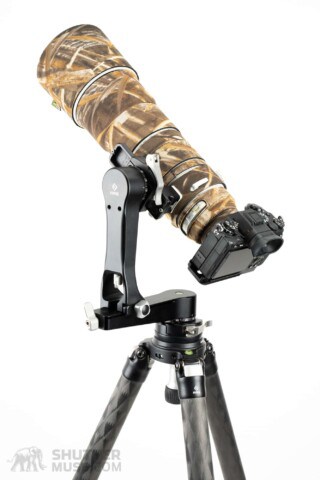

Gimbals with a cradle mount are heavier, bulkier, and usually more expensive than a side mount version of the same head. Still, a cradle mount is easier when mounting a heavy lens to a gimbal because gravity is on your side. The cradle can support the weight of the lens while you tighten the quick-release clamp. With a side mount gimbal, you must support the camera and lens with one hand while tightening the clamp with your other hand. When mounting a camera to a side-mount gimbal, there is slightly more potential for an expensive accident.
From a functional point of view, there is also a slight difference that many people are unaware of. When a side mount gimbal is perfectly balanced, letting go of your camera will return it to a horizontal position. When a cradle mount gimbal is perfectly balanced, both in the fore/aft position and in the up/down part of the cradle, letting go of your camera will do nothing. The camera will perfectly maintain its position at whatever angle you leave it.
In the latter case, with the full cradle, there may be some situations where it is beneficial to leave your gimbal unlocked but pointing upwards or downwards. Perhaps towards an animal’s nest or den. Maybe this tiny time saver, not having to reposition your camera a few degrees, might make the difference between getting a shot or not when the subject finally appears.
I take the lighter-weight option nine times out of ten, but your opinion might be different. As I get older, my confidence in one-handing a 600mm lens into a side-mount gimbal without dropping it will likely lessen, too. And, should I develop arthritis in my hand or fingers, the easier mounting of the cradle gimbal will suddenly seem more appealing on a cold morning.
The Best Gimbal Tripod Heads
This table shows you the list of products I will review further in this guide. I didn’t choose these products blindly, so if it made it as far as being included in this gear guide at all then it has already shown some merit. If you don’t have time to read the in-depth guide, then these links might save you some time.
| Gimbal | Check Price | Notes |
|---|---|---|
| ProMediaGear GKJr Katana Pro – #1 Choice | ProMediaGear / B&H / Amazon / Adorama | Free US shipping direct from ProMediaGear. International shipping is available. |
| ProMediaGear GKJr Katana Pro Side Mount | ProMediaGear / B&H / Amazon / Adorama | Free US shipping direct from ProMediaGear. International shipping is available. |
| ProMediaGear GT2 Tomahawk | ProMediaGear / B&H / Amazon / Adorama | Convert your ball head into a gimbal. Free US shipping direct from ProMediaGear. International shipping is available. |
| Really Right Stuff PG-02 Mk2 – Highly Recommended | RRS / B&H Photo | |
| Fotopro Eagle E-6H | Amazon / B&H / Adorama | |
| Gitzo GHFG1 Fluid Gimbal | Amazon / B&H / Adorama / WEX | |
| Wimberley WH-200 | Amazon / B&H / Adorama / WEX | |
| Wimberley Sidekick | Amazon / B&H / Adorama | |
| Wimberley MH-100 MonoGimbal | Amazon / B&H / Adorama / WEX | A gimbal for your monopod! |
| Oben GH-30 | Amazon / B&H / | |
| Induro GHB1 | Amazon / B&H / Adorama | |
| Benro GH5C | Amazon / B&H / Adorama | |
| Sirui PH-20 | Amazon / B&H / Adorama | |
| Magnus GH-M1 – Low budget option | B&H Photo |
ProMediaGear GKJr. Katana Pro Gimbal
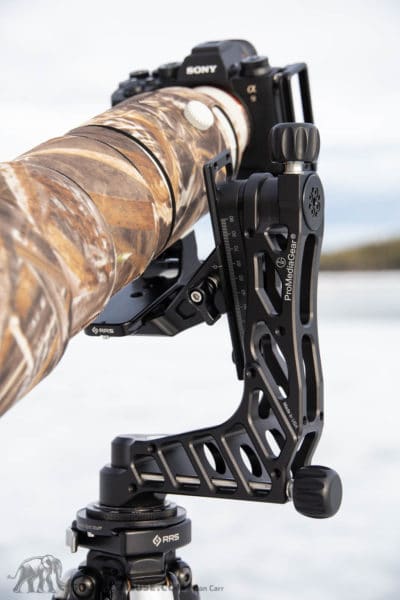
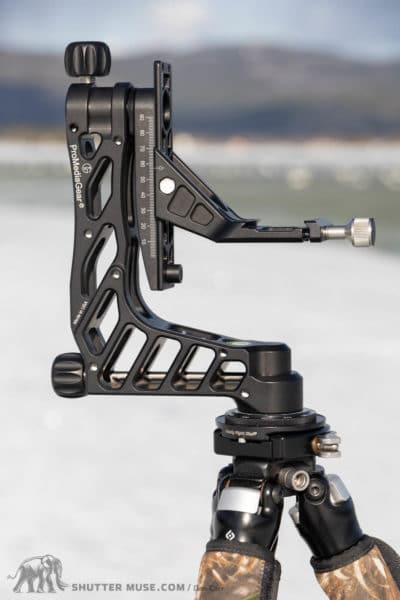
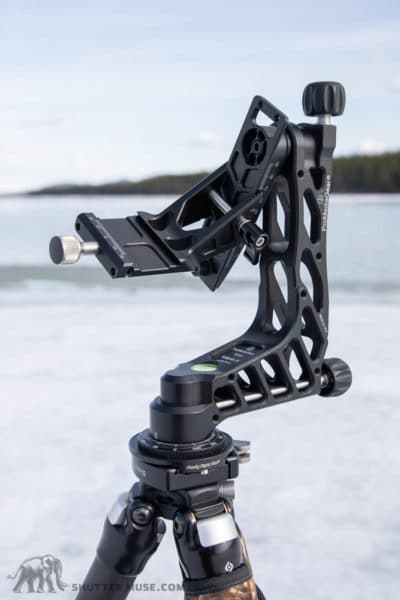
At only 2.4 lbs (1.08kg), the GKJr. Katana Pro gimbal from ProMediaGear is one of the lightest gimbals on the market. This impressive feat is achieved by machining a skeleton-like structure out of a solid block of aluminum. Despite the weight-saving design, the Katana Pro gives up nothing as far as stability is concerned. This head easily holds the biggest lenses on the market, such as a 600mm f/4. Equally, it’s at home when paired with much lighter options such as a 100-400mm, 200-600mm, or the Canon 100-500mm, where some other heavy, larger gimbals feel overkill.
Not only is the GKJr Katana Pro light, but it’s also relatively compact compared to heads like the Wimberley WH-200 or the Gitzo Fluid Gimbal. If you opt for the cradle mount version, the cradle is easily removed from the head to help pack it into your bag. For ultimate portability, the head’s side mount version drops the weight even further to just 1.8 lbs. If you’re someone that travels with your gear, weight and packability are always a concern. Check out my detailed review of the GKJr Katana Pro gimbal for more details on why this is one of my favorites.
ProMediaGear GT2 Tomahawk
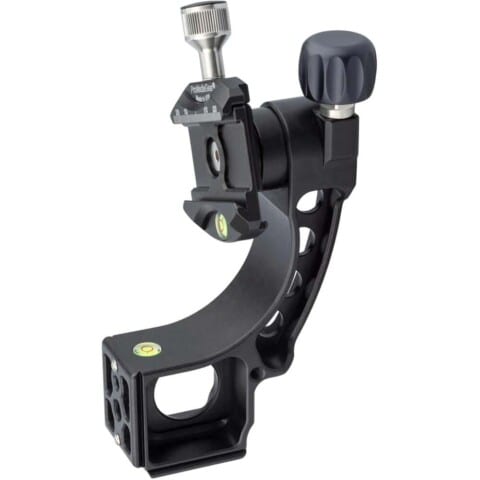


The ProMediaGear GT2 Tomahawk is best described as half a gimbal. Comparing the Tomahawk to the GKJr. Katana Pro, you can see it closely resembles the vertical part of that gimbal, using the same clamp and bearings. The dovetails on the bottom of the Tomahawk allow you to clamp it onto a ball head, thus using the ball head’s panning base for the gimbal rotation.
Wimberley first developed the half-gimbal concept with their Sidekick model. ProMediaGear has taken this concept further by adding 1/4″ 20 and 3/8″ 16 female threads that allow the Tomahawk to be used on top of a monopod. This ingenious design can negate the need to carry a separate monopod head or a full-sized gimbal head if you are already traveling with a ball head.
The downside of the Tomahawk is the nearly-$400 price point. It won’t be the best option for everyone when many full gimbals can be purchased for the same price or less. However, suppose you often travel with a high-quality ball head that can support a telephoto lens in this configuration. In that case, it does save considerable weight over carrying that ball head and a full-sized gimbal. The GT2 Tomahawk weighs just 15.3 oz / 434g.
Really Right Stuff PG-02 Mk2




The Really Right Stuff PG-02 Mk2 is a modular gimbal head that can be configured as either a side-mount or cradle-mount gimbal. RRS calls these models the PG-02 Mk2 Side-Mount and the PG-02 Mk2 Full-Gimbal. One model can be converted to the other using a hex tool, so you’re not committed to your choice if you change your mind after purchase.
Related: Really Right Stuff Ball Head and Gimbal Guide
Unique to the RRS gimbal is the option to use it as a multi-row panoramic head. This is made possible by the modular design that allows the vertical arm to be moved along the horizontal arm to place the lens’ optical center directly over the point of rotation. As well as a great gimbal and panoramic head, the Side-Mount model is an excellent alternative to a ball head for any other non-telephoto shooting, such as landscapes or macro.
The new Mk2 version of the PG-02 is lighter and a little less bulky than the original version while maintaining the same stiffness and 50lb load capacity. It also features an innovative design that allows you to simultaneously lock and unlock the pan and tilt mechanisms with one hand. The design and machining are beautiful, and the gimbal’s movement is buttery smooth with even the heaviest setups.
Fotopro Eagle E-6H
Fotopro is a Chinese manufacturer that has a broad portfolio of support products. Unlike most companies, they haven’t chosen a pricing sector of the market to concentrate on. Instead, they manufacture everything from sub-$200 tripods up to $1400 tripods. This is a very different way of doing things. Imagine if Gitzo or Really Right Stuff made sub-$200 tripods and their top-of-the-line offerings, or if Ferrari made a cheap 4-door sedan?
I don’t think this approach helps people’s perception of the brand’s products, but I’m here to tell you that their high-end Eagle Series products are the real deal, and any qualms should be put aside. The Fotopro E-6H is an excellent gimbal head and deserves your consideration, with some weight capacity caveats.
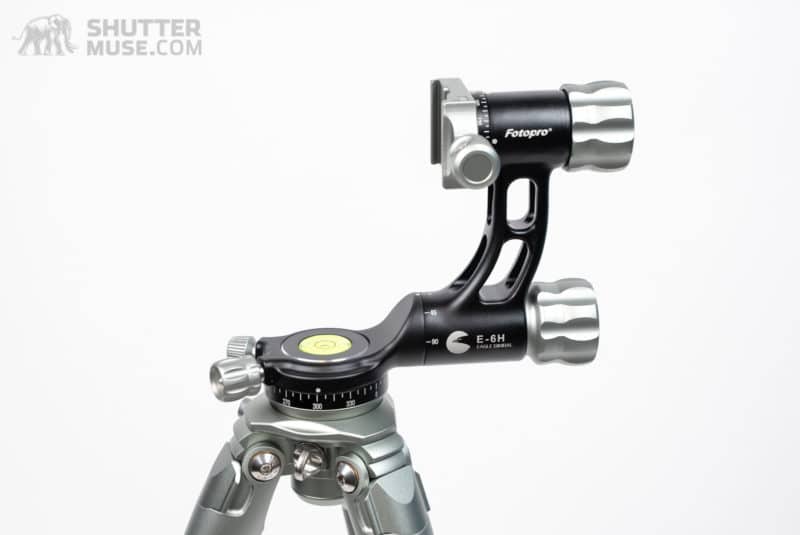
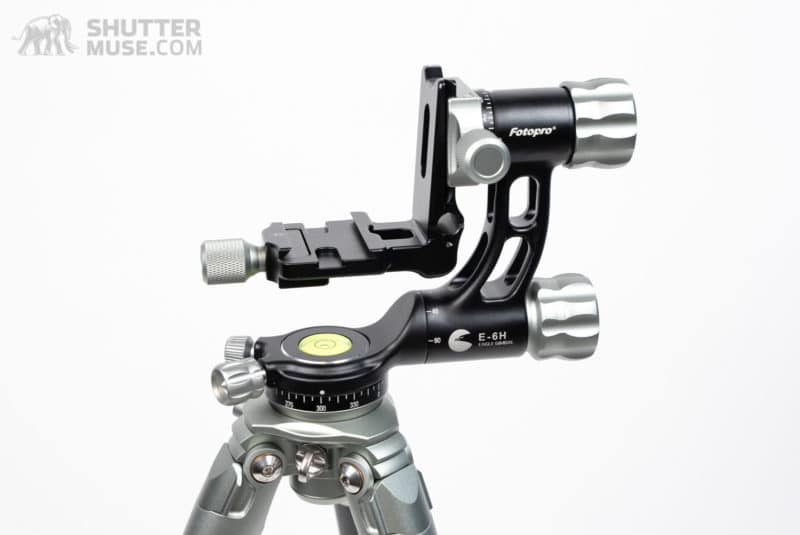




The E-6H gimbal is tiny. It’s roughly half the size of any of the other gimbals in this guide, and it’s easily the lightest at 911g with the cradle or a mere 700g in side mount mode. Despite its small size, it has some of the smoothest pan and tilt motions of any gimbal in this guide. It’s so smooth that I had to ask Fotopro if it used fluid cartridges because it’s smoother than the Gitzo Fluid Gimbal. As it turns out, it does not. But you certainly wouldn’t know it by using it.
This gimbal is full of features that don’t exist on other gimbals. Firstly it has click stops that can be engaged on the panning base for panoramic photographers to get perfectly repeatable results. Secondly, the vertical arm can be swivelled forwards or backwards up to 180 degrees. This means you can shoot straight up to the night sky or down to the ground for macro work. Alternatively, fold it down for more compact travel.
Other unique features include toolless swapping between cradle mount and side mount and locking screw-lock knobs on the Arca-Swiss clamps. It even comes with a panning handle so you can use the head for filmmaking. And yes, this head is smoother than many cheap video heads, so that’s an entirely plausible scenario.
Gitzo GHFG1 Fluid Gimbal
The Gitzo Fluid Gimbal is surprising in a few ways. Firstly this is a fluid head, so fluid cartridges dampen rotational resistance of the horizontal and vertical panning joints. Fluid heads deliver a much smoother panning motion, as discussed in the RRS FG-02 fluid gimbal section. A panning bar is included in the package to aid with smooth motion when shooting video.
The relatively low price point is the second most surprising thing about the Gitzo gimbal head. Gitzo products are known to be of the highest quality, and many photographers aspire to own them, but the price point can sometimes be prohibitive. In the case of their GHFG1 Fluid Gimbal, the price is a bargain when you compare it to other models in this gear guide. It’s much less than half the price of Really Right Stuff’s fluid gimbal, and it’s cheaper than some of the most popular gimbals, such as the Wimberley WH-200.
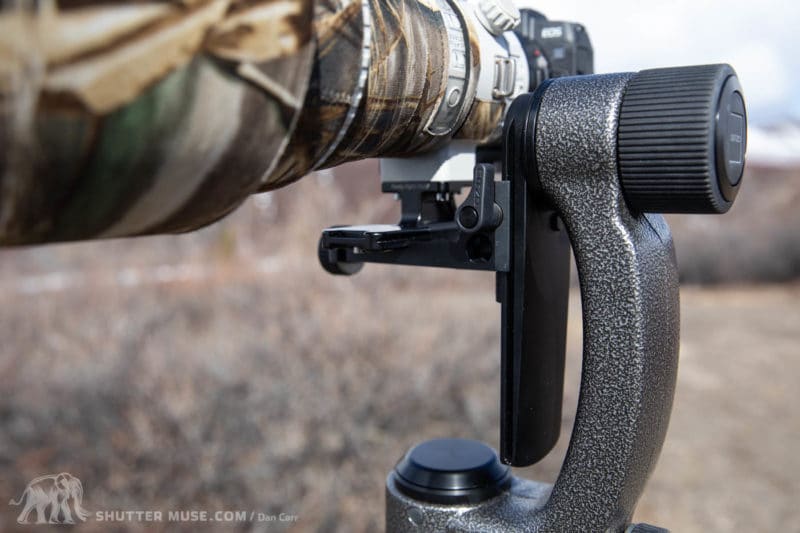
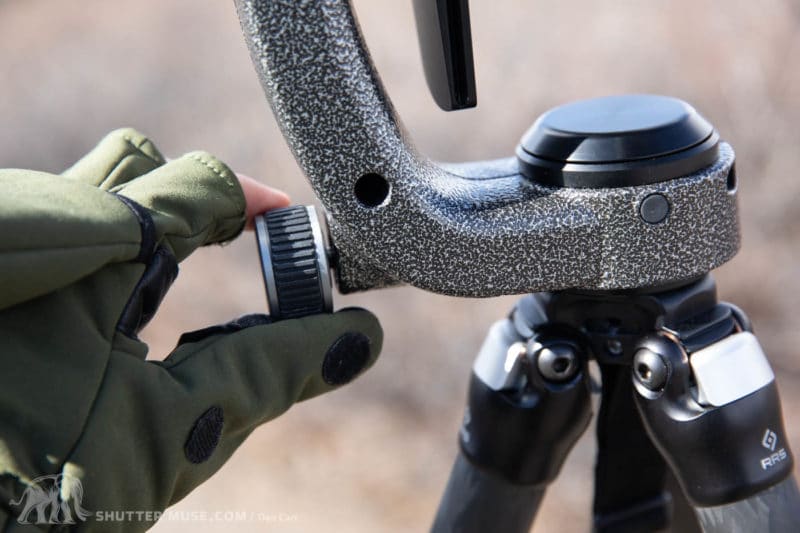
The main downside of this gimbal is that they do not offer a side mount version, which would have saved a little weight and size. The overall design is also significantly bulkier than many other options, such as the ProMediaGear Katana Jr or the Fotopro Eagle. It’s also lacking a bubble level. Something that is offered by the PMG Katana Jr, the RRS gimbals, the Fotopro E-6H and more.
Wimberley WH-200
The Wimberley WH-200 design has been around for decades and is popular with many photographers. The design is bland, but they are among the smoothest gimbals on the market, and their durability and general robustness have been proven over time. If you tend to beat up your camera equipment in harsh environments and don’t mind the sterile, industrial look, the WH-200 is one of the best options.
Wimberley MH-100 MonoGimbal

This product is an outlier in the gimbal guide, but I don’t think the guide would be complete without it. The WH-100 MonoGimbal is designed primarily to act as a small gimbal for your monopod. However, the base of the head is an Arca-compatible dovetail, which means you could attach it to a regular ball head to give it some gimbal characteristics (see photo below).
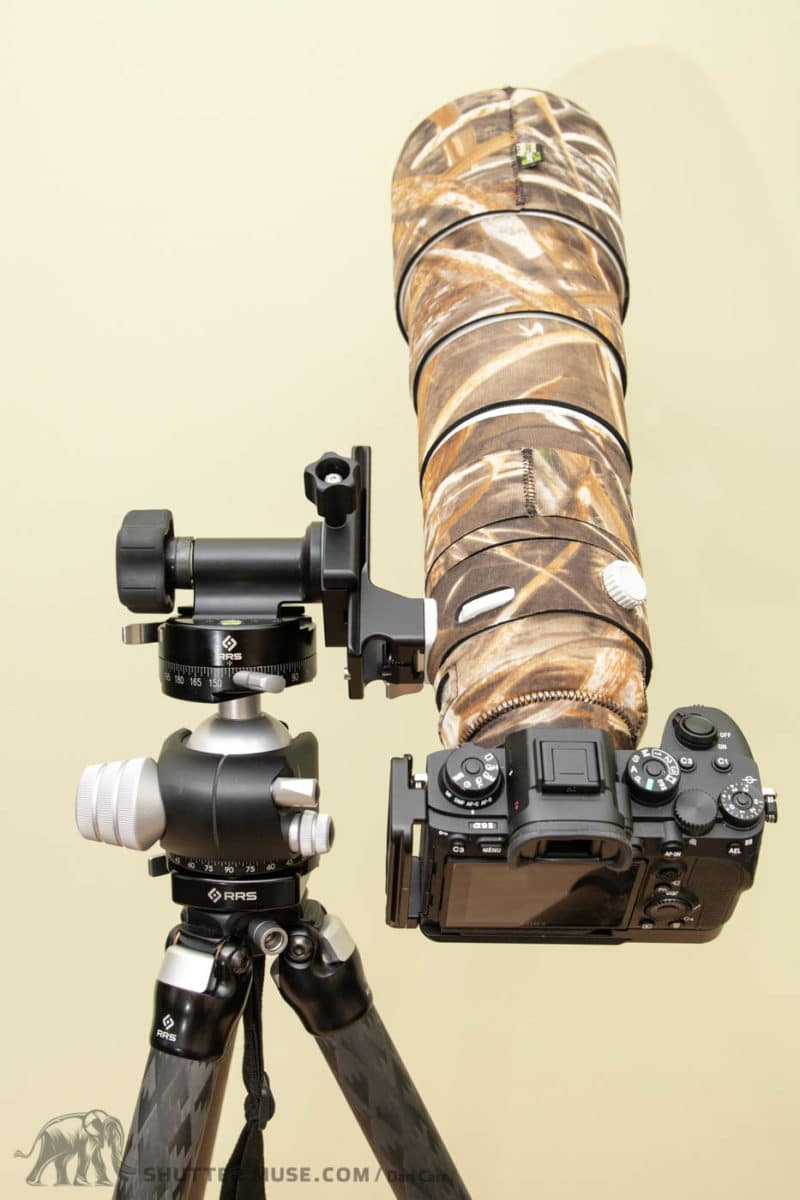
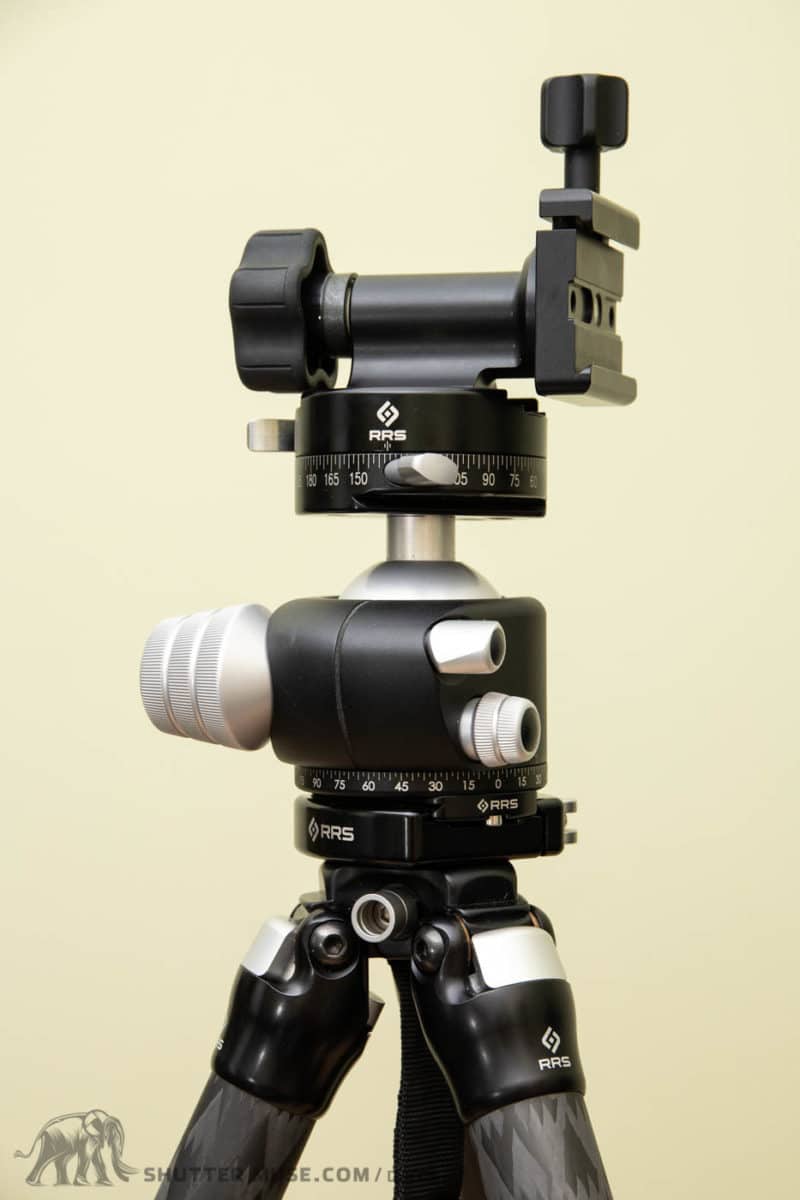
Wimberley Sidekick
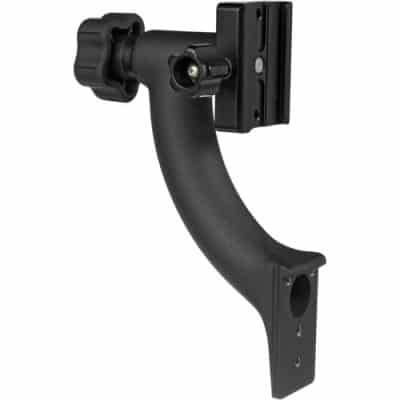

The Wimberley Sidekick is an interesting design for someone who must carry both a ball head and a gimbal head. Instead of switching heads entirely, this handy gadget converts your existing ball head into a gimbal. To do this, your ball head must have a separate panning base lock knob and an Arca-Swiss compatible clamp.
To install the Wimberley Sidekick, release the ball lock and flop the clamp into your drop notch, positioning it vertically, then tighten the ball as much as possible. Now clamp the Sidekick into the now vertical ball head clamp and loosen the ball head’s panning base lock knob to rotate the gimbal.
Choosing the sidekick instead of a proper gimbal will give you some weight savings, but, as with the ProMediaGear GT2 Tomahawk discussed earlier on this page, the head’s effectiveness depends on the smoothness of your ball head’s panning base. Ball heads are not designed to have heavy weights levered on one side while rotating. They are designed to be locked down tightly. Even some of the best ball heads on the market struggle to deliver a smooth horizontal pan when used in this out-of-scope manner.
In my testing, the RRS BH-40 and BH-55 ball heads produced the smoothest pans with a telephoto lens and the Sidekick. Many other heads can hold the off-centre weight, but the pan fluidity is slightly compromised. Still, this might be a worthwhile tradeoff for the overall weight savings if you otherwise need to carry both a ball head and a full-sized gimbal.
At about $250, you save a significant chunk of change with the Sidekick compared to the full Wimberley gimbal ($550), but it’s only really a saving if you already own a high-end ball head to pair it with. If you need to buy a new ball head, your total bill will undoubtedly be larger than the cost of the Wimberley Gimbal or the better ProMediaGear gimbal.
Oben GH-30
The Oben GH-30 deserves a spot on this list because it brings gimbals down to a price point that makes them accessible to many more people. At just $250, this is an excellent beginner option for people who don’t do much wildlife photography but want something that will make life considerably easier for them on the odd weekend excursion. It’s also a good budget option if you have booked a costly wildlife photography vacation and suddenly realize that you should take a gimbal with you but don’t want to break the bank.
Induro GHB1
The Induro GHB1 is a moderately sized side mount gimbal with a 22lb capacity and a relatively low weight of 1.7lbs. It is suitable for smaller and lighter telephoto lenses, such as a Sony or Nikon 200-600mm, a Canon RF 100-500mm, Nikon Z 100-400mm or a Nikon Z 400mm f/4.5.
Sirui PH-20
The Sirui PH-20 is a carbon fibre gimbal that comes equipped with an Arca-compatible cradle and an included option to remove the cradle and convert it to a side mount gimbal. Sirui strangely does not mention the included side mount option on its website, despite being one of its best features. In full cradle mode, the PH-20 weighs 1163g or 2.56lbs. When the cradle is removed and the smaller side mount clamp is installed, the gimbal weighs 899g or 1.98lbs. These are the measured weights on my digital scapes. Ignore the lower weights suggested by Sirui.
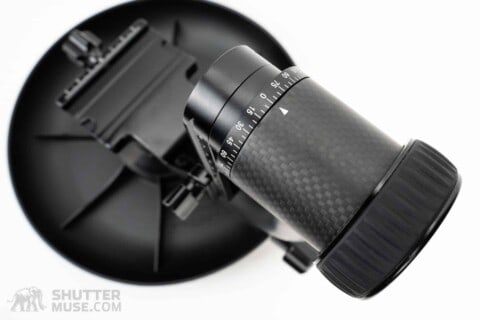





Protecting Your Gimbal
Use Your Gimbal With a Skimmer
Most will use a gimbal head on a tripod, but there are many times when a lower point of view is beneficial. While it’s possible to spread your tripod’s legs to attain that low angle, it’s cumbersome to repeatedly lift a tripod and adjust its position while lying flat on your belly. The heavier your lens, the harder this becomes.
Which Gimbals Do I Use?
On My Tripod

For many years, I was using an original RRS PG-02. It’s built like a tank but also has the exquisite finishing we expect from RRS. I love that it can be broken down into two pieces for travel, but a significant downside was its considerable weight. When this PG-02 gimbal head went out of production for a few years so they could redesign it, I started my search for a replacement since I could not very well recommend a head that was not in production.
My search led me to the ProMediaGear GKJr. Katana Pro. This head has now become my gimbal of choice and number one recommendation. The buttery smooth bearings, combined with its fantastic capacity-to-weight ratio, make this an excellent gimbal tripod head for any size of super-telephoto lens. If it falls within your budget, you won’t be disappointed.
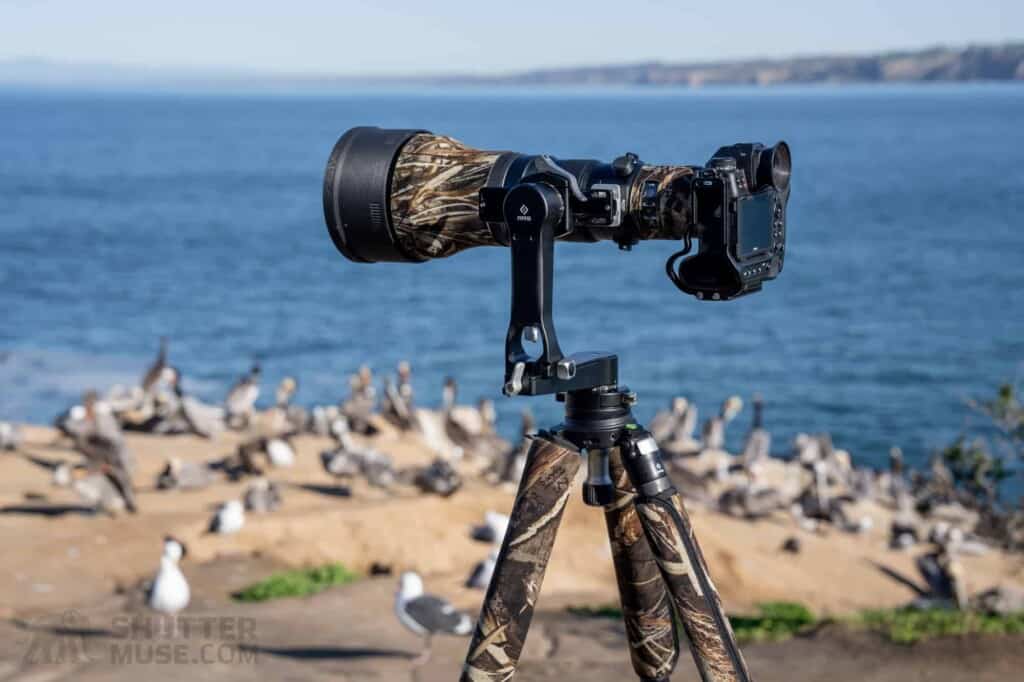
After using the Katana Pro for a while, RRS relaunched the PG-02 as the new PG-02 MK2. I own this updated gimbal, and while it is a little lighter than the original PG-02, it is still nowhere near as light as the Katana Pro. For that reason, it’s a gimbal that generally stays on the tripod in my car. I always choose the Katana Pro for travel and hiking.
On My Monopod
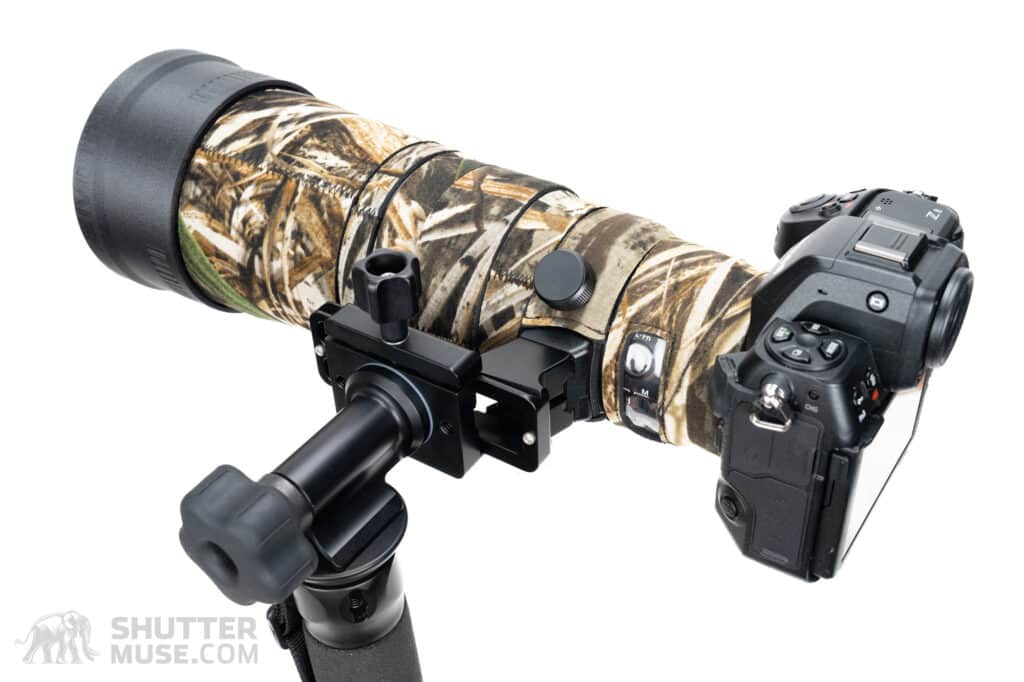
When using a monopod for wildlife photography, I prefer to have a gimbal head on it, just as I do on a tripod. It gives me an Arca quick-release and makes it much easier to aim my lens at subjects above and below my eyeline. However, gimbals designed for a tripod are too big for a monopod and create an unwieldy top-heavy setup. The solution for most people will be the Wimberley MH-100 Monogimbal. I rate this as the overall best monopod head and find the sub-$200 price very reasonable.
The second monopod gimbal I use is the ProMediaGear GT2 Tomahawk. Essentially, the GT2 Tomahawk is the top half of their top-rated GKJr. Katana Pro Gimbal. It can be used on its own as a monopod head or combined with a ball head to create a gimbal tripod head. I love this head, but the near-$400 price point makes it more than twice the price of the Wimberley Monogimbal and, therefore, much harder to recommend to people who simply need a monopod head. Instead, the GT2 Tomahawk is best chosen when you also want to use its ability to convert a ball head into a gimbal head.
If you usually travel with a tripod, a monopod, a ball head, a gimbal, and a monopod head, now, with the GT2, you can simply carry the tripod and monopod, along with a ball head and the GT2. You are saving yourself the weight of the monopod head and much of the weight of a full-sized gimbal. Brilliant for travel, if you don’t mind the rather steep price!


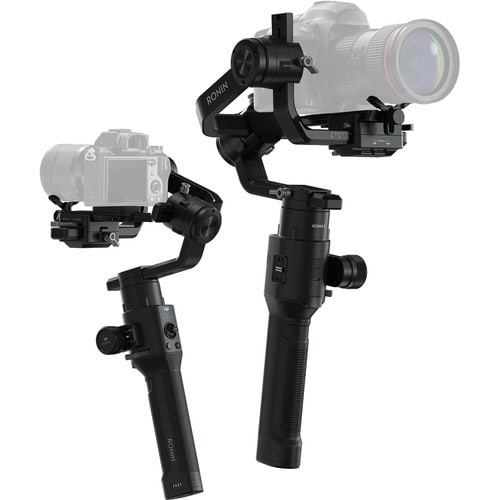
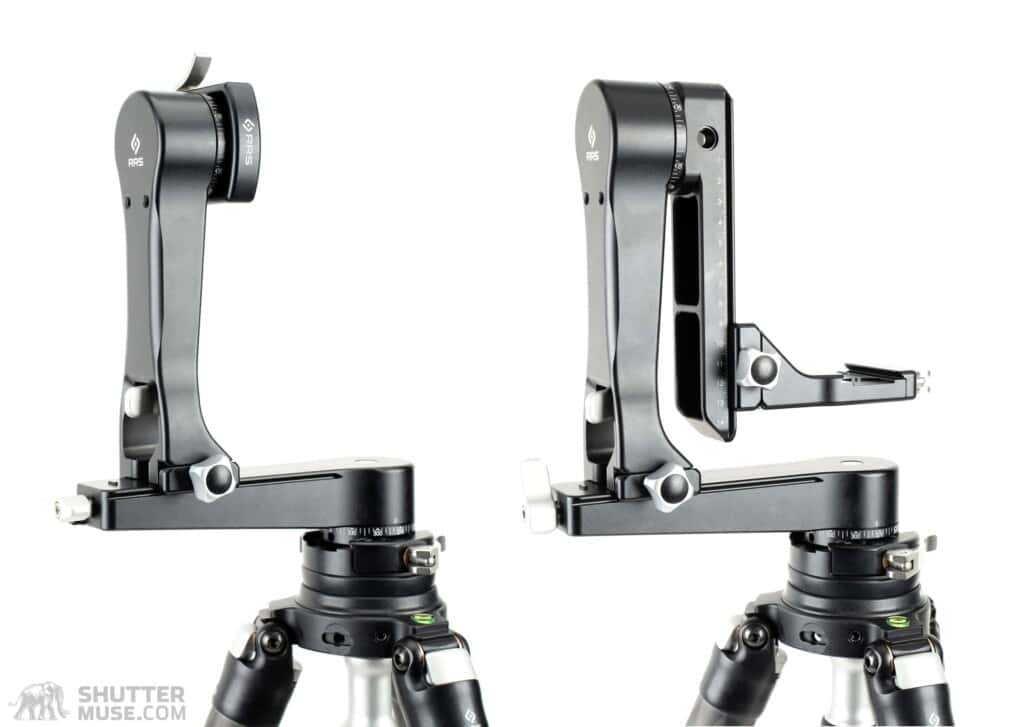
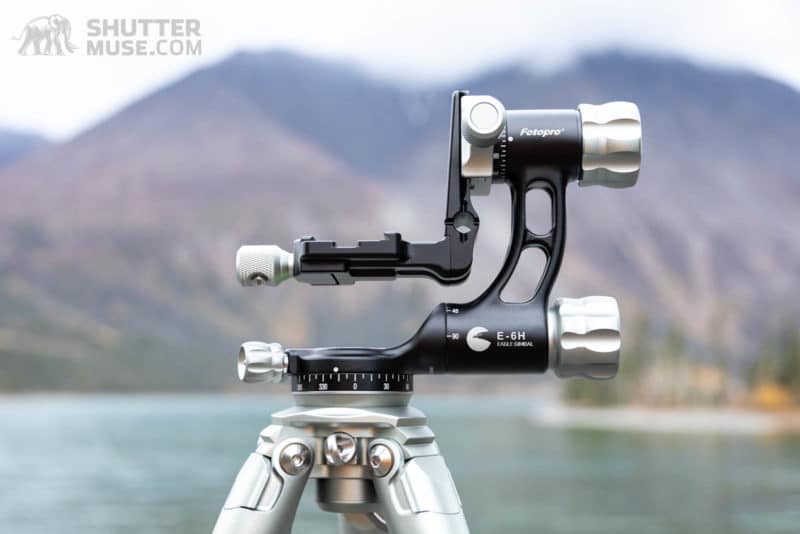
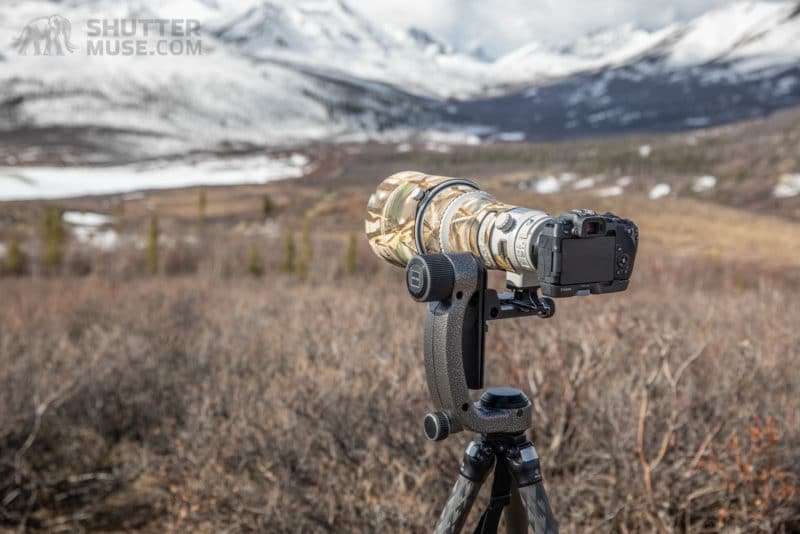
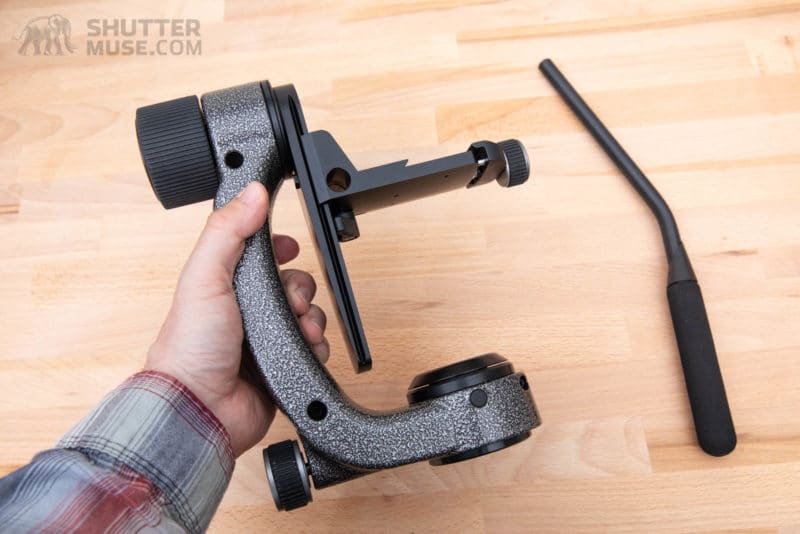
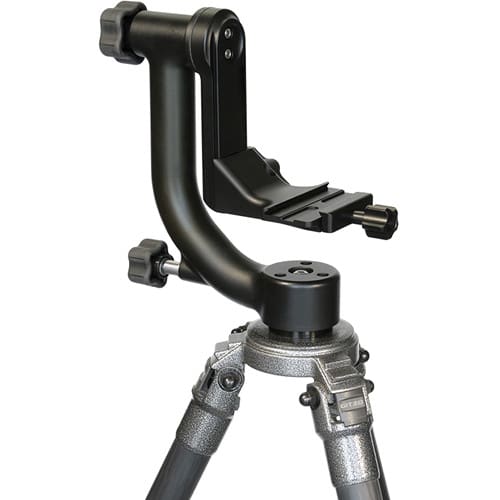
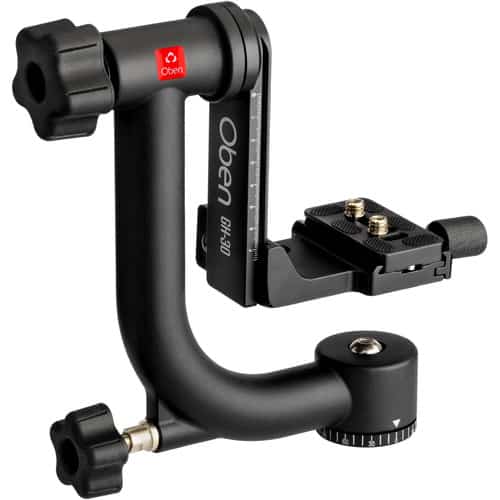
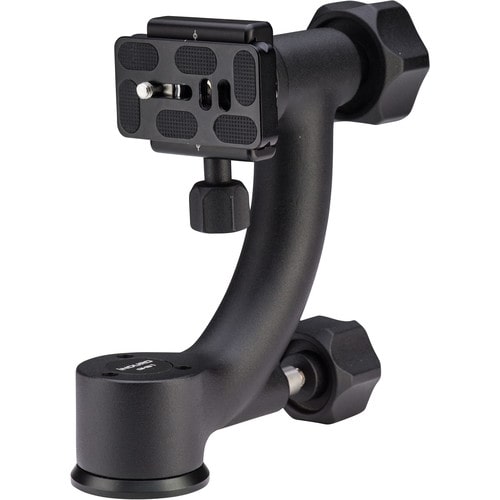
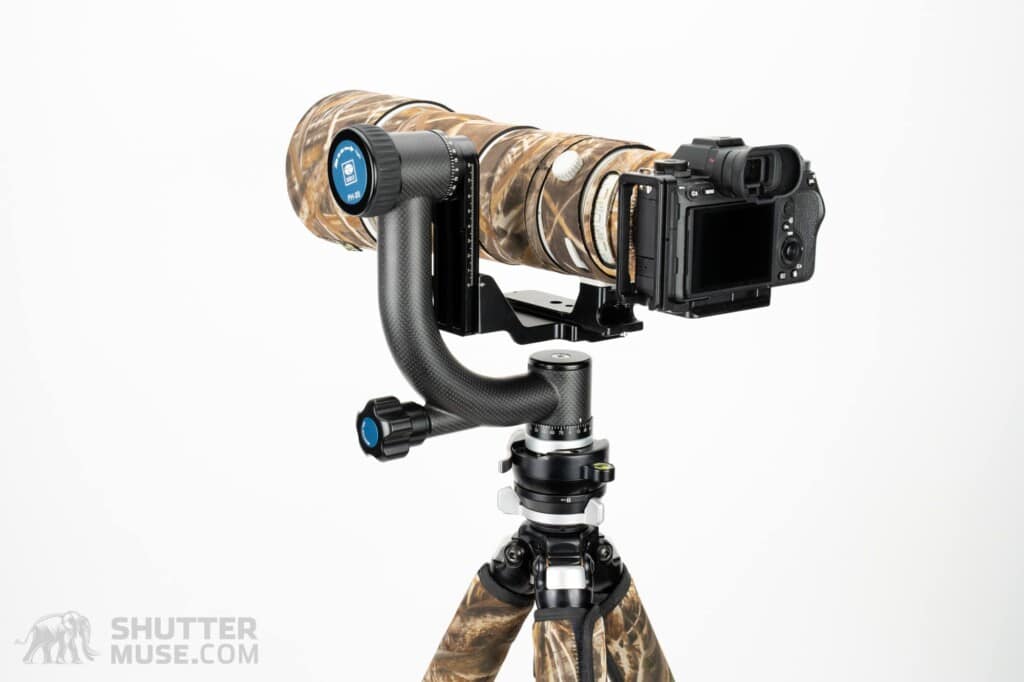
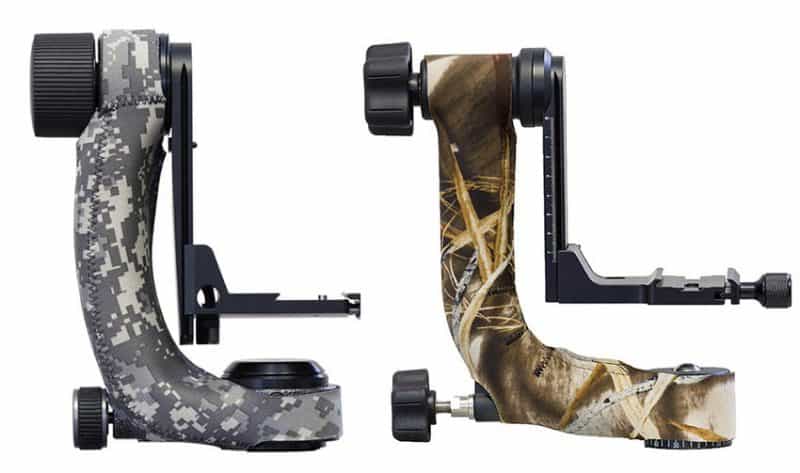
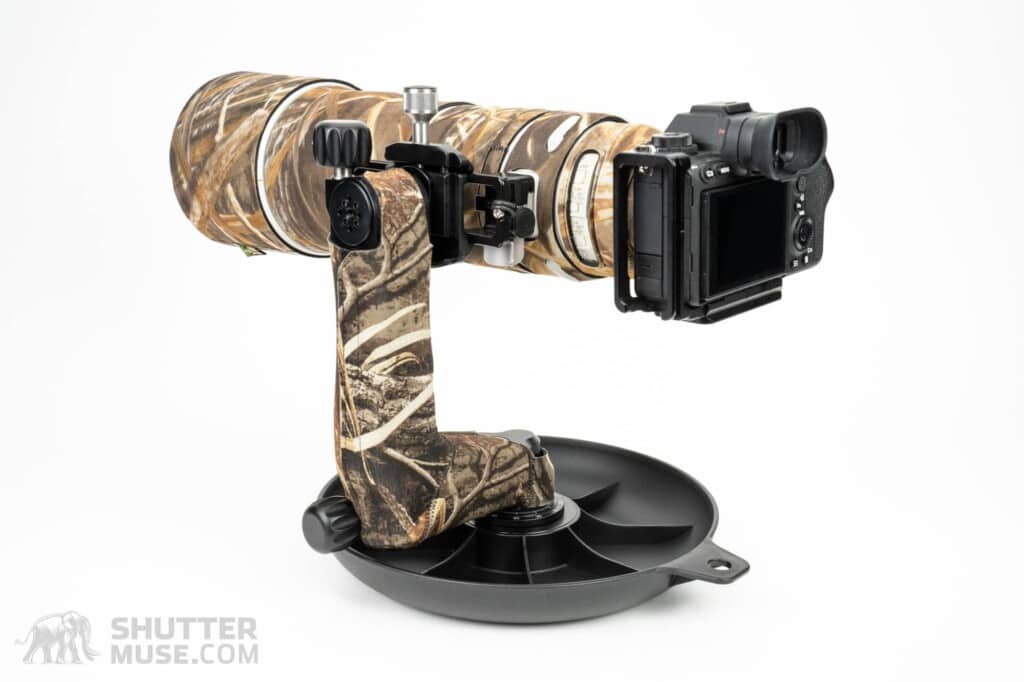
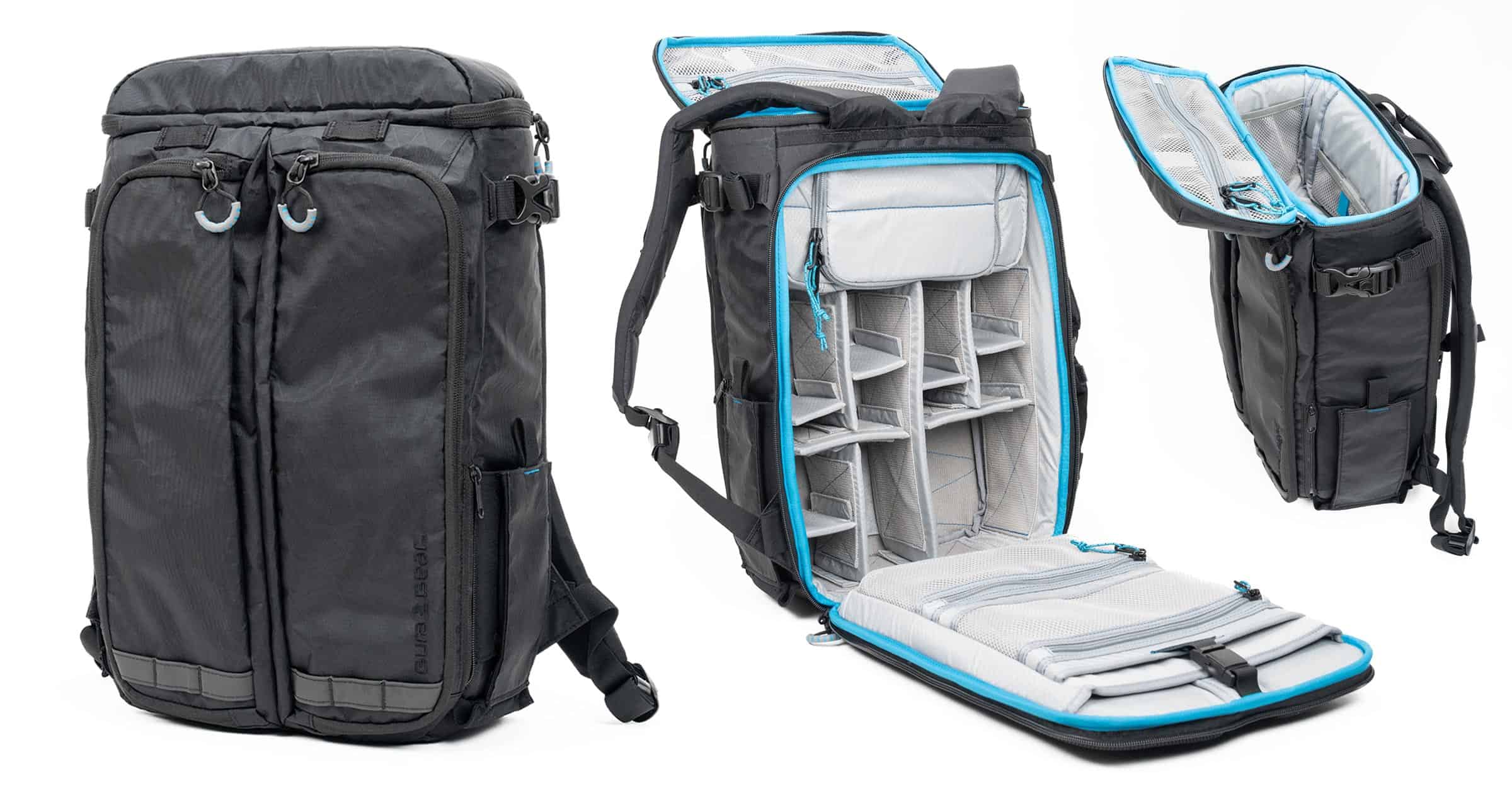
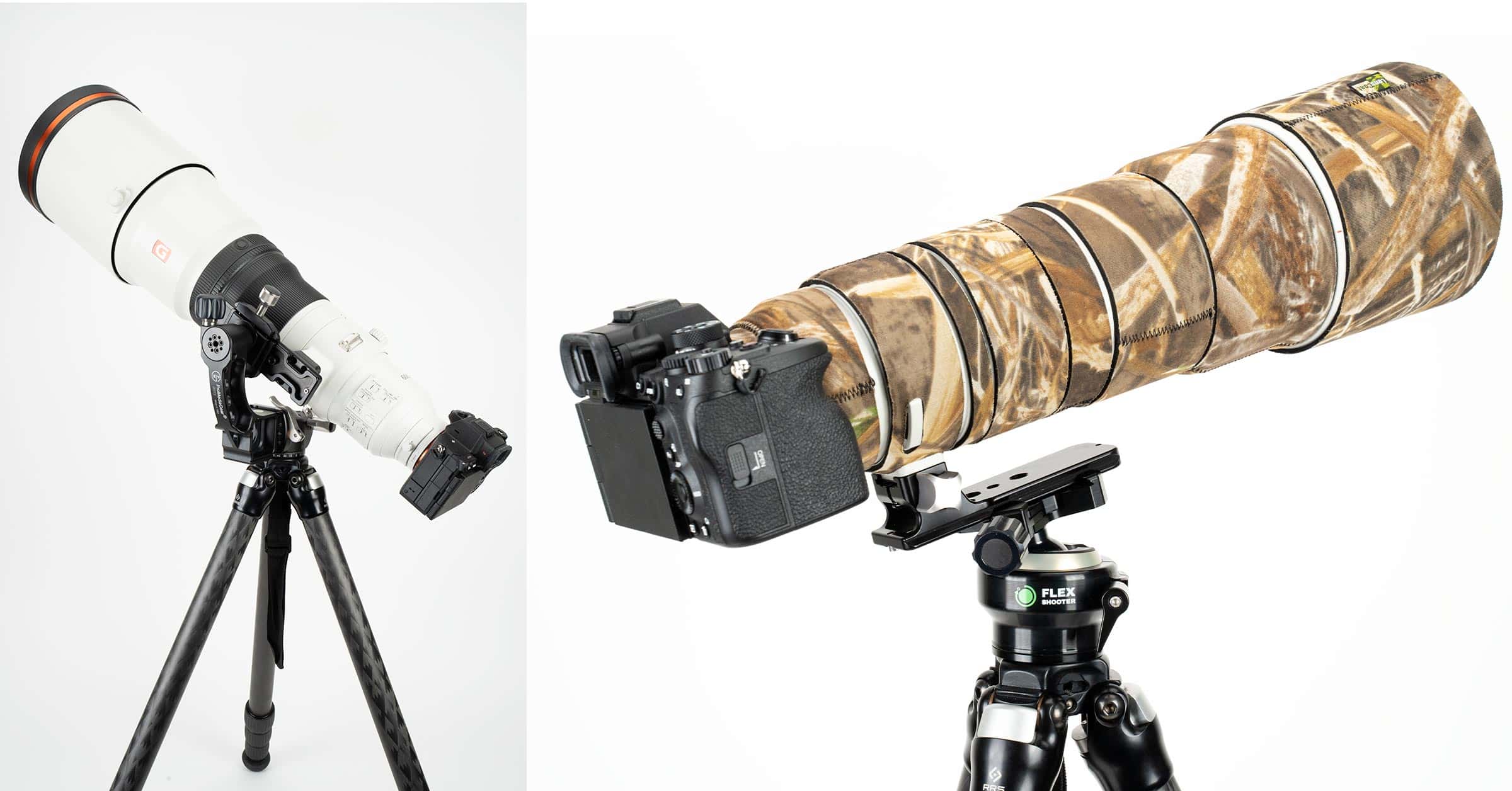



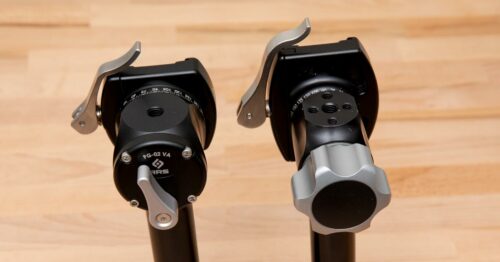
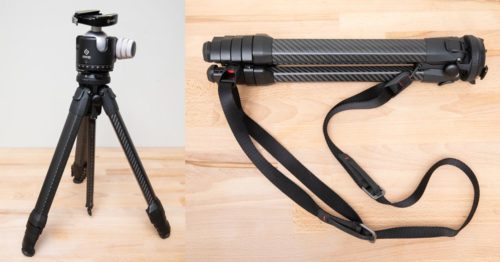
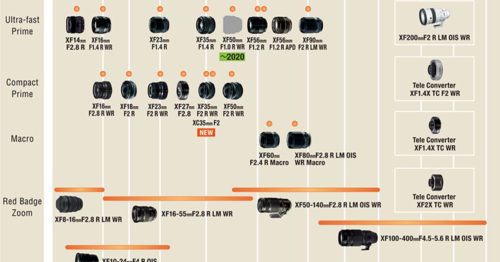
Hello,
I have a Wimberley WH-200 gimbal head that I use with a Really Right Stuff tripod. I primarily use it with my Sigma 500mm F4 Sport lens. It is an older design, but it works well and is dependable. The weight and size make it cumbersome for air travel. I’m surprised you didn’t include a Jobu design gimbal in your review which are made in Canada and I’ve heard good things about.
Yes Wimberley is certainly dependable. I would like to get my hands on some Jobu gimbals at some point to see how they are, yes.
I use a Jobu Design HD4 gimbal head (for my Canon 200-400mm). It’s great. Prior to buying, I had narrowed it down to that or the Wimberley. Specs were basically the same for mine and not a lot of difference in price but the Jobu was (is) much, much lighter (about 1kg vs 1.4kg). Easy decision in the end. I ruled out the RRS gimbal mainly on cost but also because it was even heavier again (about 1.6kg?) and I couldn’t quite get my head around the side-mount design.
Thanks Mal. Yes, a lot of people struggle with the side mount idea. Hopefully the section about that will help people…
I’ve had both the Wimberley, and the RRS previously but I agree I like the Jobu Design HD Mk.IV gimbal better, especially combined with their Algonquin carbon fiber tripod in Arctic cold weather.
You should also get your hands on the ProMediaGear GKJr. Katana Junior Telephoto Lens Gimbal Head. At 2.4 pounds, it can handle up to a 600mm as per their website. I used my Canon EOS EF 500mm on it prior to selling it in favor of the new Canon EOS EF 500mm f/4 DO IS II. I have found both work excellently on it and my Wimberly flash brackets are easily compatible and attachable to it as well.
Thanks for the tip Ron, I’ll put that on my to-do list. I haven’t heard of that one before.
I was very enthusiastic when i first heard about the Gitzo fluid head and ordered it right away (since the price of the RRS fluid is quite a steep).
I was very disappointed. Either something was wrong with my copy, or i would not call it very fluid. Not any significant difference to my “normal” gimbal head.
And the cradle being off axis is maybe not a dealbreaker, but certainty annoying. Especially sitting in a hide with already limited lens movement.
And the cradle does not have “slots” for stopping screws on your arca swiss.
So you either need to have a really long plate on your lens, or remove the stopping screws.
Other than that i like the build, and the knobs.
Currently using a Promediagear Katana Jr, which is really nice, buy still thinking about the RRS fluid one 😁
I’m testing the Katana Jr right now. I’m going to be adding it to this guide. I’m impressed with it so far, it’s a nice size.
I currently use a LensMaster RH-2 which I really like but it doesn’t allow for changing the vertical height to balance my 600 F/4. I see that you show a picture of the new Benro PL100LW in your link but no review. Did you get a chance to test the Benro?
Good spot, John. I actually created the header graphic a long time ago and at that time I thought I was chatting to Benro about borrowing some gear to test out. For some reason they have since gone quiet and I haven’t yet been able to get it in my hands. I guess that’s on the to-do list maybe for a 2019 update to this article…
By the way, you don’t need vertical adjustment to balance a lens… Vertical adjustment is only useful because it allows you to make small changes to the viewfinder height without adjusting the whole tripod. Personally I use a side mount gimbal which by design has no vertical adjustment, and I don’t miss it one bit.
The vertical adjustment on gimbals like the Wimberley WH-200 is definitely functional. If you leave it low and remove all tension, the lens will (if properly balanced front-to-back) tend to go horizontal, even if you point it significantly above or below the horizon.
If you raise the camera so its center of gravity is at the pivot point, the camera has no natural tendency to return to horizontal. You can as readily leave it include 45 degrees up or down, to the limits of travel.
Thanks,
John
Hi Dan.
Thanks for this article, very interesting comments about the side mount, my only observation is that apart from the RRS style of construction (multiple sliding joints) there is no adjustment to bring the axis of the lens over the rotational axis of the gimbal which would add a side load to that bearing which could cause the gimbal to be less smooth. The cradle type solves this by having the centre line of the clamp over the rotational axis.
I have the Benro GH2 aluminium (magnesium?) gimbal. I was at a show where Canon had a Wimberley gimbal to display their 600 f4 lens and lent another lens (possibly only a 500 f4) to the Benro stand directly across the isle, I went back and forth between the two gimbals and with my toolmakers head on I was not able to find enough difference in the quality of the movement of the two units for my photography heart to justify spending the extra for the Wimberley gimbal.
Several years of amateur use and I’m still very happy with my choice,
Cheers, Graham.
“would cause the gimbal to be less smooth” If you have a good gimbal with good bearings, that’s a non issue. I guess it could be a problem with a very cheap one, but it’s not one I have ever heard of. I never ever adjust the side position of my RRS even though I could if I wanted to. I see no discernible difference in smoothness however long the leverage is.
Glad to hear the Benro GH-2 is working out great for you. Hoping to test some Benros soon! Thanks for your input.
No gimbal for photography, but really pleased to read the side-mount comments as I’ve been oscillating back and forth between the comfort of the familiar design and the weight/size benefit of side-mount.
Have a powered Pan and Tilt system on the way soon (hopefully – Kickstarter project) – so gimbal has to wait for now but good input for that selection process. Thanks for the article.
You’re very welcome Nigel.
Thanks for the thorough comparison! I’m researching gimbal heads right now, still in the learning phase and not yet sure what to buy. Jobu has a nice article describing the pros and cons of side mount vs. top (cradle) mount gimbals at http://www.jobu-design.com/Whats-the-deal-Side-mount-vs-Top-Mount_b_3.html
Thanks for sharing that!
Some of the side mount gimbals look as though it might be a bit more awkward to attach the lens.
And I’m not a fan of quick release – I feel more secure taking the time to screw a conventional ARCA clamp – I’ve seen articles that described the unfortunate result of attaching gear or removing it, with a quick release clamp. I guess this is all in the mind – “quick release” doesn’t mean being careless, and my only rationale for my preference IS just being more careful, so it’s probably no more than “personal preference”.
Living on the opposite side of the planet from B&H, the range available in my camera store is more iimited – and I had been looking at the Benro/Induro GH2. (For some funny reason the company calls their stuff Benro in some countries and Induro in others!) Now I’ll have to do some more thinking!
Benro and Induro are two separate companies! Some of their products look similar, but they are not the same.
I wouldn’t recommend a screw-knob clamp on a side mount gimbal because it would require you to hold the lens with one hand while repeatedly screwing the knob around.
Also, it might be worth checking shipping options from B&H. I don’t live in the US either, but it’s often still the cheapest and easiest way to get gear. They ship basically anywhere.
Quick release vs screw mount – good point,Dan – obviously it WOULD be awkward on a side mount.
I did go ahead with the Benro – bought their GH2C carbon fibre gimbal (from B&H) – it’s fine, for my purposes.
You may well be right about side mounts – it’s a bit tricky shopping for gear like this on line, instead of being able to see the different choices “in the flesh”. I was looking for two things – stability (obviously), which is available with either side or crade mount (just a question of tightening the screw) – and flexibility/movement, which – I think I can now see (having had the opportunity to actually use my own gimbal) – is actually available with both. With moving subjects though, I suspect that flexibility/movement of the camera in the gimbal to track the subject is easier with a cradle mount. But you would know far better than I do – I haven’t even seen a side mount, let alone tried one out.
Yeah it’s tough shopping like that, I agree! A good side mount still has all the same angles of movement as a cradle so it really shouldn’t be any different. I can’t say I have ever been left wanting with my side mounts 🙂
So $500.00 for the Gitzo gimbal head is well priced?
I guess we come from different economic structures.
It’s not about economic structures. It’s about relative pricing vs. quality. For what you get, yes, $500 is well priced. If you were able to find a Ferrari for sale for half price, that would be a well priced Ferrari, right? It would still be expensive, but it would be a good price for product you are buying. The Gitzo is several hundred dollars cheaper than the similar RRS gimbal.
Thanks Dan great detailed review. The Gitzo is fantastic and is a real bargain, Induro and Benro are from the same one Chinese company I was told, they infringe on so many patented tech snd also produce One Legged Freak and about 50 other brands, no morals no research and development, everything is stolen design. Although I do have a mini Induro Gitzo systematic ripoff tripod that is wonderful, flawed and faulty which I managed to fix as their support is non-existent unlike the great RRS and Gitzo, I support and love my gitzo bits but they dont make this mini systematic version but Gitzo did manage to make sure Induro cannot be sold in Europe/UK, it’s a start I guess in blocking these hacks from selling their theft, I bought from B&H had shipped here to the UK . Great site Dan thanks.
Interesting information. Thanks for taking the time to comment and thanks for the kind words. I have wondered if Benro and Induro are the same company… but never found a real answer to that.
“One Legged Freak” do you mean 3 Legged Thing? If you do, that is definitely incorrect as they are a British company and I have direct contact with them. I am not aware of a company called One Legged Freak.
Hi Dan,
Excellent article. Several years ago and after much research, I opted for a Wimberley Sidekick. I had tried using my Canon 500 mm lens on just a ballhead, RRS BH-55, but there were some limitations and issues.
Now I mount the Sidekick on the BH-55 when using the 500 mm lens on a tripod and have been well pleased…….until last night!
I was photographing the lunar eclipse and found myself acting like a contortionist trying to aim the lens almost 90 degrees up. The camera was blocked by the ballhead.
So, please cure my ignorance and tell me there is a solution that I was not ingenious enough to figure out. Is there a way to configure the BH-55 and Sidekick mounted on a tripod so that a 500mm lens on a 5d mark iii can shoot almost vertically?
Thank you for your time and best regards,
Rodger
Hey Rodger. Thanks for the kind words, and sorry to hear of your troubles! Unfortunately I can’t think of a solution. By design, and for stability, a camera should be directly above the tripod legs. If you want to point the camera up, or at least close to 90 degrees, then the tripod will always get in the way unless you have a tiny camera. Likely the best solution is to shorten one leg to get some angle from the tripod, but you’d certainly not want to let go of the rig!
Normally the Sidekick is mounted to be vertical. To provide more clearance between the camera and the ball head, try tilting the top of the Sidekick slightly back towards you. A small amount provides a bid increase in available vertical angle.
Good tip!
Hi Dan;
Have you had any experience with gimbals in salty sandy environments (shore birds). Was wonder if carbon fiber (the SIRUI or benro) would be a good consideration for that kind of exposure.
Hey Jim. No need to choose carbon for that reason. Firstly, your biggest issue is going to be sand in the bearings and joints and not any corrosive problems, which I guess is what you’re getting at? The metal heads are aluminum so they won’t rust, but if you do get them salty you should wash them off in clean water. If you are really concerned you could use a rain cover to prevent blowing sand getting into the cracks https://shuttermuse.com/best-camera-rain-covers/
I have used my RRS gimbal on many beaches and never encountered issues.
Thanks for the excellent review, Dan.
Question: When I’m out and about I often mount my lens (Canon 500mm) directly on a sideways facing ballhead (one that pans), so the ballhead itself functions as a Sidekick – is this considered a safe and proper way to use a ballhead or is it a set up no one would contemplate?
I picked up a Nest NT-530H gimbal on Ebay a couple of years ago. It’s well made, very strong, controls are smooth and I love it. I think Nest have produced 2 versions, mine is the MK1, which is not arca compatible so I have an arca clamp permanently mounted on the Nest bespoke plate, it’s a bit cumbersome but it works and I’m used to it. The MK2 is, I believe, fully arca compatible.
Have not heard of the Nest but I’ll check it out when I update this guide in 2020.
As for your question about the ballhead… I actually meant to do a post about this. If you only want to travel with a ballhead then it is a somewhat viable way to use a lens in a pinch. The two main downsides are that the (heavy) weight is not centred over the middle of the tripod so it makes the setup a bit unsteady if you take your hands off it. Secondly, there will be much more stiction in panning, and particularly tilting, with this setup compared to a very good gimbal. I would say that it is a reasonable solution if you are trying to save weight and not have to travel with both a ballhead AND a gimbal.
Another solution is to buy the vertical arm of the RRS gimbal only, and mount this on top of a ballhead. Then you use the panning base of the ballhead for panning, and the tilt of the RRS vertical arm to get your tilt. This is my own weight saving technique that I use when I know I need to travel with both gimbal and ballhead and have tight weight constrictions.
Hi, great review. Happy to note that side mount ones are gaining ground. I’m from India and here availability is an issue. I use the Wimberley WH 200′ one of the brands which are easily available, and very happy so far. Hope it lasts a lifetime ?
It should last! They are very sturdy 🙂 . Yes, I’m glad side mount ones are gaining ground, too.
Thanks for a good article, Dan. It’s one of several I have read in the course of researching my next big photo purchase. I will be needing a gimbal for my old Nikkor 800mm f/5.6 manual focus, a real beast of a lens coming it at nearly 12lbs. I believe an advantage of a cradle mount is that it adds another dimension of balance adjustment. The forward-backward positioning of the rig on the plate, as is what you do with both the cradle and side mount, is for horizontal balance such that the camera-lens rig tends to return to a horizontal position when it is tilted up or down. This is where the vertical adjustment offered by the cradle comes in. When proper up-down position of the gear rig is achieved, it will stay right in position when hands are removed, instead of tipping upward or downward to return to the static horizontal position achieved with the first adjustment. I can see how this is not important for some, but I have decided it will make it easier for me to move, point, and keep the lens exactly where I want it. Thanks again!
Glad you found it helpful Ken. I must admit that I still don’t follow your logic on vertical position. I can’t see how vertical position effects the balance at all, but as long as you’re happy with your chosen solution that’s all that matters 🙂
Here’s a thought experiment for you.
Mount a 1/4″ bearing on a wall so its axis is horizontal. Like a coat peg, but nearly frictionless.
Now take a wooden ruler and drill 1/4″ holes in it down its center, every 1″.
When you mount the ruler on the bearing using the center hole, you can rotate the ruler to any orientation and it’ll stay there. But if you put the bearing in any other hole, there is a tendency to hang in one specific orientation that grows as you approach the ruler’s ends.
If your camera was mounted to that ruler in the same manner as a camera on a cradle-style gimbal — like on a shelf attached to the face of the ruler at 6″, so the camera faces left when the 1″ mark is up and the 12″ mark is down — you will find the same thing happens as before you added the camera. If you attach the ruler to the bushing exactly at the center of gravity, you can easily point the camera in any direction up or down and it’ll just stay. But if you lower the camera and put the bushing into the hole at the 1″ mark… the camera will swing down and point horizontal always.
I hope this helps!
This is great. Thanks for sharing, John.
Thanks Dan
I’ve bitten the bullet and ordered a Nikon 200-500mm after my test trip to BC and now am looking at a gimbal head.
The RRS PG-02 and Gitzo Fluid Gimbal both fit my budget and look like winners.
Quick question — I do a small amount of video and fair number of panoramas that I stitch together in Photoshop,
For this use case which one would you lean towards if it was for yourself?
The Gitzo is available in Toronto for a great price right now, and I was wondering if both of these gimbals are competent for both tasks.
Appreciate the help — very informative post.
Tom
Additional accessories?
Bit of a neophyte question — are there any additional accessories I need to purchase to attach the Nikon 200-500mm to either the RRH pG-02 or the Gitzo Fluid Gimbal, such as a mounting plate? Or are they both ready to go out of the box?
Cheers
Tom
The Gitzo gimbal comes with the mounting plate, the RRS gimbal does not. You could ask RRS which of their plates bests suits that lens and they will tell you. That said, the RRS gimbal, and most others, use the Arca Swiss standard so any brand of plate would work if you don’t want the RRS plate for some reason.
Thanks Dan
I did check with the companies directly.
In the end, with the Gitzo product, would you feel comfortable shooting video?
It’s on sale in Toronto and significantly cheaper than the RRS at the moment (<$600 CDN) — but that might be false economy if I end up buying a separate gimbal for video.
(This is completely new territory for me, as you can probably tell.)
Hope you're getting lots of great shots up in the big wild!
I guess it depends how important the video is to you. If it’s your business, then I think you would end up with a different head at some point. The Gitzo head is ok for video, but the biggest issue is that it uses slightly different fluid cartridges for the pan and the tilt. This gives it a slightly different feel and resistance when panning or tilting and I suspect that would have an effect on the fluidity of a camera movement that includes a certain amount of each one. That said, it’s far from terrible and the price you have found is good. If it’s video for personal use, on occasion, then it would probably be sufficient. If the store has a good return policy you could always give it a try?
Perfect. Thanks!
The advantage of the cradle over the side mount is additional options for fine tuning the balance of your camera in the gimble.
Here’s a great video showing how to properly balance so the rig does not move when you let go.
https://www.youtube.com/watch?v=OWAzwWOaXwc
I guess that’s true. But in all my gimbal use I can’t say this has been an issue. Note that when he begins to set the vertical he suggests starting off with the point of rotation lined up with the centre of the lens. This is exactly where it is on a side mount gimbal at all times. With a tiny bit of friction from the locking knob, my lens stays in place when I let go just as it does with a cradle. I still don’t think the potential benefits outweigh the weight difference.
I found this information very helpful. I do not have a gimbal and need one. I currently have a 150-600mm but will be upgrading to a 500mm within the upcoming weeks. I know I will need to use a tripod a lot more with this beast of a lens. Since I am dumping a ton of $ into the upgraded lens, I don’t have too much extra to spend on other particulars. This is probably a stupid general question, but do you need certain gimbal heads for certain tripods? I have a decent Manfrotto tripod. I am entrusting a very expensive investment on top of 3 legs. So I want to be sure I get the right thing.
Dan, try to get your hands on the Flexshooter Pro (or the Mini) to test, I think you’ll love it. It is a ballhead / gimbal all in one with a double ball design which also allows you to forget about needing a leveling base. There is absolutely no lens creep whatsoever. So much easier to travel with too given form factor and the fact that you no longer need to also carry a ballhead for landscapes. I have given up using my 4th Generation Mongoose and my Wimberley 2H-200 gimbals completely.
I have read a lot about this. I’m definitely curious! I’ll ty and get one for review. Thanks for sharing your experience with it. What size of lens are you using with your one?
I have tested the flex shooter pro, and although a great middle ground between a dedicated gimbal and ball head, I found it less smooth than most gimbals … in particular tension increases and is uneven with pans as vertical movements are made. Range feels limited.. in the end I went with a promedia Katana Jr pro gimbal and very pleased with its performance. Good day
I’m quite surprised that you didn’t include the well made but relatively inexpensive lightweight (2.125 lbs) Canadian made Jobu Design Heavy Duty Mk IV gimbal in your list. I own a prior version of this model and I’m quite pleased with it and at the current price of $549 CAD its a steal.
Dan,
Lately I’ve been using a Sidekick, for the reasons you suggest, and I’ve been pretty happy. But just the other day I noticed that my K-40W Sirui ball head now has a little (very little) rotational play when the ball is locked down. It appears the connection between the mounting plate and the ball (small cylindrical neck w/ allen head bolt) has been slightly compromised. My set-up is heavy (Tamron 150-600mm G2 – Sony A99ii – Sidekick – Sirui K-40W on a Benro Mach3 carbon), but I expected the ball head to handle the load. Considering this situation I’m wondering if the Sidekick’s lateral connection produced a rotational load, a torque, that the K-40W couldn’t accommodate. NOTE: Sirui is being great and honoring their 6-year warranty.
Thanks,
Scott
Have you heard about anything like this before ?
Hey Scott, I haven’t heard of anything like this before. I’m glad Sirui are sorting it out for you. I also wouldn’t really consider your setup to be that heavy compared to some other long lens rigs so that’s a bit disappointing to hear the Sirui could not handle it.
Hi Dan,
Super informative article! Can you please tell me what tripod is in the pics? It has no centre column, and the legs fold out to 90 degrees allowing the camera to get almost to ground level.
thanks
This is the RRS TVC-24L II. You can read my guide to RRS tripods here: https://shuttermuse.com/really-right-stuff-tripod-guide/
I may be a little late to the party but i was wondering if you could tell me why the RRS PG-02 Pano-Gimbal Head is no longer available?
I actually wasn’t aware of this, but after you pointed it out I went and looked around. I see that it’s no longer listed on the B&H site. But on the RRS website I found a clue… they are “Currently re-designing the part.”
I have no idea what they might be redesigning about it. It was/is already a most excellent gimbal so I wouldn’t expect to see much of a change. Should you still wish to purchase one, shoot me an email! I have a brand new one still in the box. I have been meaning to put it on eBay but would be happy to sell to you if you’re interested.
RRS tend to be quite slow at making new products so I doubt we will see the 02 back on the open market anytime soon.
Dan,
I’m really late to this party. Assume you sold your PG-02 a long time ago, but I figured it wouldn’t hurt to ask.
Thanks, Dave
I did. They are working on a new version. When it comes out, I’ll purchase it so that I can update this guide with thoughts on the latest. However, I have no idea at all when the new one will come out. It could be years from now. RRS is not known for their speed. I would not bother waiting if I were you. Get a PMG Katana in the meantime and when the new RRS comes out, you could easily sell that if you really wanted to move to the RRS.
Have you tried or looked at the Fotopro Eagle Series E-6H or E-9H gimbals? Just wondering to see what you thought of them. Thanks
I have not. I have tried to contact them to see if they can provide a gimbal for testing, but so far have not had a response. Your comment is a good reminder for me to follow up on this again… thanks!
John, good news! I just spoke to the CEO of Fotopro and they will be sending a gimbal and a set of matching legs for me to test. I’ll publish a dedicated review, and then they will also (most likely) be added to this guide. At first glance it appears that they will do more than enough to be added to this “best of” list. So, thanks again for the reminder, and stay tuned…
Leofoto PG-1 Professional Gimbal Head – their tripods are a great value. Fairly new company that makes quality products for less. I love my carbon tripod. Anyone familiar with the Gimbal head? I think it would stack up agaainst 80% of those mentioned.
Leofoto do most of their business by making copies of other existing products from other manufacturers. They do so from a country that has less laws about doing such things. It appears that the PG-1 is a carbon copy of the PMG Katana Jr head. I struggle with this way of doing business. Should brands like that be supported? What do you think?
As a side note, I have in the past contacted them about reviewing some of their products that are not carbon copy clones of other people’s hard work. If you dig into their catalog they have some interesting items hidden amongst the clones. In some ways this infuriates me even more because it proves they have the expertise to create, from scratch, some interesting products. Yet for their ball heads and gimbals they just copy other existing heads and undercut the price of home-grown brands. I actually wish that people like B&H would stop selling the clone products.
When I asked Leofoto, they declined to send any products for review on this site. Possibly the only brand that has ever declined. I suspect they generally don’t send products to review sites because people always point out that they just copy other people’s products and they don’t come across well from that.
Thanks for this big effort reviewing all these gimbals 🙂
Leofoto make sound products with 10 year warranty. There distribution and support is better in UK and South Africa. Their LS Ranger self-levelling tripods ad other accessories are not highly original but break new ground. As far as I know no other manufacturer who has invented a process to coat an entire carbon fibre tripod in tough camouflage. They also sell this is a kit with the GP-1.
The Leofoto GP-1 weighs 1kg ie 0.2kg lighter than anything above including PMG Katana Jnr! Those chasing after lighter gear for hiking etc can go lighter and for less. The only lighter gimbal I’ve found is the Zenelli ZX carbon fibre, which carries a breathtaking price!
The other Gimbal you should check out is the S African Gimpro. It’s very solid with superb bearings but heavy. Available in the UK
links
Bob Rigby is also the UK dealer for Acratech https://www.bobrigby.com/gimpro/item/gimpro_gimbal_head_mkii
Hi, to save weight, you’ve suggested a side mount gimbal.
1. Could you lighten further using a Wimberly sidekick or monogimbal on an existing pan head or ball head? I’ve tried using it on a panning base plate and it does not appear to swivel or pan well due to weight being offsite to the side.
2. Do you have any recommendation on what ball head to couple the sidekick or monogimbal with?
This would only really save weight if you were also needing to bring a ball head with you. Otherwise I think the sidekick and a good enough ball head to pan well, would actually weigh more than the lightest gimbals such as the PMG one.
You are correct that panning with the weight off centre does cause more friction and you therefore need to have a really exceptionally smooth and robust ball head to make this work. I have done it with success using the RRS BH-55, but even then it’s not as good as a gimbal.
Another product recently recommended for those (like myself and you) who use mirrorless Sony is this Jobu Design Junior BWG gimbal
This is very light weight and I wonder if you have any experience about this company.
I don’t. But I’ll look into it! Thanks for the sugestion.
Excellent site. Lots of helpful info here. I am sending it to some friends ans additionally sharing in delicious. And of course, thanks on your effort!
Thanks Dan,
I just read your review on the Fotopro Gimbals. You are spot on as far as I am concerned. I purchased the E6-H just after asking you about it in August and really like it for the same reasons you pointed out. It is extremely versatile. I coupled it with an Innorel RT90C tripod. The tripod is a little heavier, for carbon fiber, than most but the top legs are 40mm. It is a very sturdy tripod. It came with a solid cnc mounting pan and an adjustable bowl for leveling( similar to the Foto Pro Eagle Series tripod leveling), both 75mm. The tripod was less than $350.00. I think it is well worth the money and could probably hang with the high dollar tripods. No center pole but they make one for it as an option.
Aha! You must be the person that brought this to my attention then. I could not remember exactly who it was… thank you! I will have to investigate that tripod, too. Cheers!
I was searching for a comparison/review for the Benro GH-5C carbon fiber gimbal. Also wondering if the threaded mounting (to the tripod)was not sufficient. I had heard that there was only 1 thread of engagement-very unacceptable to my toolmaker’s mind. Also, does it come with a side mount?
Thanks!
Hi Dan, Thanks for this great comparison. Which gimbal head would have the least amount of static friction for tilt rotation? So far I have been using the Wimberley Sidekick and it has very low static friction. Thanks for your insight. Best regards, Ted
Good question. The RRS gimbals have extremely low tilt friction. I would say that this is the lowest. The Katan Jr is also very good.
Hey Dan, thanks a lot for this article. You’ve made a great job. I also engaged in the same topic and it would be great if you share your thoughts about it.
I’m not seeing anything on your site apart from a bunch of reviews about mobile phone gimbals which are VERY different products for a different purpose.
Nice review, thorough and comprehensive. I shoot a lot of wildlife with a 600 and also use the RRS gimbal which is a fine piece of engineering but have recently been using a friend’s GimPro head and have to say that I would have bought it instead given the choice. Take a look and maybe give Ralph, the owner a call and see if you can get a review sample. Why is it so good? Engineering grade bearings make it indescribably smooth, it is billet aluminum so incredibly rigid, has options on fixing vertically or horizontally, optional extension arms for serious panning and tracking movement in a safari vehicle and can be finished in black or silver, packing down even smaller than RRS’s. Here’s the link, check out both the Gimbal and pano heads, especially the double pano heads!!: http://www.gimprogear.com/
Regards,
Ian Mackenzie.
Thanks for sending the link, Ian. I have not heard of this company before, but I’m always on the lookout to keep this article up to date. I will certainly reach out to them and see if I can get my hands on one for some testing time.
Thank you you taking the time to leave a comment. Your participation in the community is appreciated!
Hi there! How would you rate the Sunwayfoto GH-02 Gimbal tripod head?
Sorry, I have not tested that one.
Hi was wondering if you or anyone else have tested the Gitzo GH3382QD Series 3 together with a sidekick would it hold up a canon 500mm F4?
what is your thoughs.
/Cheers
The 500mm is a big lens. I wouldn’t recommend this as a permanent solution. You will have much better luck with a dedicated gimbal.
ok thanks for input 🙂
Hi guys. I’ve been wondering if it was possible to find some video stabilizer that supports a 400mm lens. I’m a Brazilian biologist and I’ve worked up some nature video productions at my work. But using a monopod or even a tripod, I can’t move easily and therefore I lack enough mobility when I want to put mobility and stabilized images together.
There are no hand-holdable products that fit this need. Only huge multi-million dollar things that you hang under a helicopter to shoot movies…
Dan,
Thank you for a very informative article. I’m new to these types of gimbals so your info is very helpful. I have a Nikon Z 100 – 400 zoom on order and therefore I’m looking to purchase one of your listedunits (probably the Wimberley or the ProGear). Can I assume that even if the lens is a zoom lens that has a barrel that moves in and out , that the gimbal is still effective and can be balanced?
Love the review. I ordered the Fotopro and gave it a go. I just couldn’t love it. I am using the ProMediaGear Tomahawk until I can order the Katana Jr.
Great article and Review. I purchased the Promediagear Katana Jr with my TR424L Tripod and added my RRS BH-55 for support duties. I have to say the Katana Jr is really easy to adjust on the fly and is really smooth with my Nikon D850 and 200-500 lens shooting birds and Airshows.
Great article,
Do you use the Katana Jr cradle mount or side mount? I am looking at the side mount as an option and it looks just as great, just lighter. Just wanted your input.
Thank you so much!
I almost always use the side mount version. I like the lighter weight!
Hey Dan,
thank you for your extensive comparison! Your review was the one that finally triggered me to buy the Fotopro E-6H. I absolutely love the innovative design, the flexibility really stands out.
Sadly, two issues mar this gimbal for me:
1.) The height of the cradle is just too low for any use. Even with my smallish hobby zoom Tamron 100-400 / F4,5-6,3 , the center of gravity is noticably above the tilt axis in the lowest cradle position. As soon as I tilt the camera more than 30°, it starts falling forwards / backwards on its own. I can use sidemount configuration to mitigate this. Same happens if I attach the camera to the cradle. Better attach an L-bracket and again use side mount. I really don’t see any use in the cradle at all, so they could have left it out if they asked me. Still, side mount seems to be a viable option and I could probably live with that.
2.) I noticed considerable drop of the camera when I unlock the tilt axis. On further investigation, the tilt axis has a lot of play. I can wiggle the know almost 1mm which translates to more than 3mm at the camera. I was so keen to open the screws at the tilt axis clamp to have a glimpse at the bearing. I was really underwhelmed to find out that there is no bearing. It is just a drilled hole with a cylinder going through. At that price I really expect some ball bearings or even better needle bearings. It seems like they focussed more on apparent build quality but cheaped out on one of the core components of every gimbal.
Does anyone observe the same amount of play as I do?
Maybe production has some tolerances and I could get a better fitting replacement. At the same time, I’m looking at a Jobu Jr. 3 as an alternative, which seems like a very reduced design but at a much higher quality at a similar affordable price. Still, the design of the E-6H really appeals to me and I’m hesitating to return it.
Best regards,
Alex
Really nice article! What IS the deal with Really Right Stuff? I have called them too about the PG-02. I should’ve gotten one when I had the chance but I didn’t have a big lens yet. I recently got a ZIgmonster but it has no stabilization. I really need some friction control or dampening. The Gitzo looks good but my rig is 18lbs. That’s just over the Gitzo limit but you really ought to have some leeway at about two thirds max or less. Seems to be enough interest in the PG-02 but maybe some of their best engineers didn’t want to make the trip from California to Utah? I wouldn’t either!
Yeah, Gary, I wonder whether the move to Utah caused issues. It seems there have been stock issues ever since. I also think that they committed a lot of production to the firearms market and potentially to military contracts, which might have impacted photo gear production. Pure speculation, but again, stock issues seemed to start once they got into that market, and for some reason, they haven’t been able to expand to keep up. It’s a real shame. I always field questions from people asking me what they should get instead of an RSS tripod or head because they can’t get the one they wanted. I can’t begin to imagine the sales they are missing out on!
Hey Dan! Guess what I just found? https://www.reallyrightstuff.com/PG-02-MK2-Pano-Gimbal-Head
It just went live for pre-order yesterday! I called and got a few answers. It doesn’t have fluid dampening but it does have a bit of adjustable tension or friction control. More so in the horizontal than the vertical direction. Weight limit is 50lbs centered and about 15 at the extremes. It has some extra 1/4″-20 holes for mounting additional accessories. Delivery time estimated in about a month so far. They said there were some issues with the previous model with things like the fluid control. I’m not wholly convinced but I really don’t see anything else out there accept a fluid video head but those aren’t gimbal and a good one is really expensive. Did you ever get to try the first version of the PG-02?
I owned the first version of the PG-02 for many years. It was fantastic. The new MK2 is on its way to me in a few weeks. A full review will be published. I’ll be testing the full gimbal version and the side mount version. It looks like there are some nice improvements on the MK2, although probably not enough difference for existing PG-02 users to need to upgrade. Keep an eye out for the review in the new year!
So I think I got a bit confused with the PG02 and the FG-02. The PG02 was never a fluid gimbal but they are releasing a new version, the MK2. The FG-02 (fluid gimbal) is still discontinued. I called again and they said they were only announcing the PG02-MK2. So maybe another FG-02 is in the works???